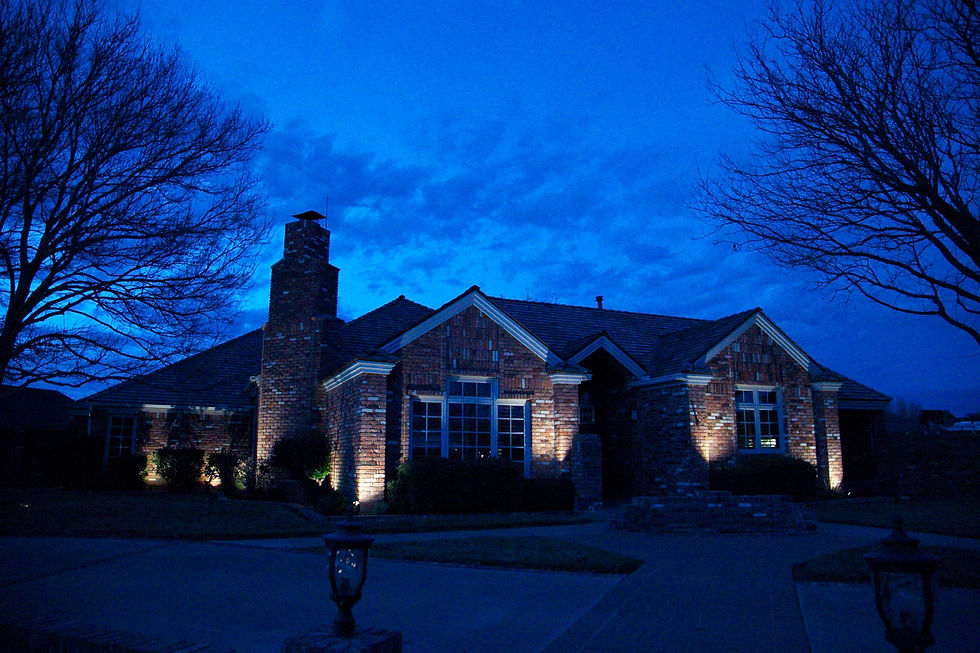The Death of Soffit Lighting
- marchaile
- Feb 27, 2018
- 3 min read

We had the pleasure of hosting a booth this weekend at the TPBA Home Remodeling Show in Amarillo, Texas, and I would like to take a moment to thank all who came out to get remodeling ideas and talk with the vendors there, including Eldorado Outdoor Lighting LLC. We had a great time and met some great people as well as the other participating vendors.
One of the most common questions I received while talking to people about our services was, "Do you guys install the lights in the roofline?" (aka soffit lights) As I continued to hear the same question over and over, I got to thinking just how popular soffit lighting has become in our area. When I drive around Amarillo and Lubbock I can't help but notice that the majority of homes with any type of lighting at all use soffit lighting. So it is no wonder that so many people have asked if we offer this design in our services. While we do still incorporate the occasional soffit light here and there, our lighting methods focus on the effect desired and the right lighting method to achieve that. Here I will explain our most used methods, what the differences are, and why soffit lighting is on it's last breath as a lighting method.
For some time now, soffit lighting has been the choice for home builders to get light onto the front of the house. It is an obvious mounting locations, the contractor can take advantage of the home's existing 110 volt electricity, and it does give off some light for the home. However, there are a few main drawbacks. One of the disadvantages of soffit lighting is that the mounting location is too close to the walls of the house. This creates "hot spots" at the top of the wall where the light originates giving an effect of an extremely bright ball at the source. This effect makes you see the light instead of what you want people to see: your beautiful house. Another disadvantage of soffit lighting is that there are only a few options for the mounting locations. Many times homes will have varying heights of rooflines, which makes some lighting locations higher or lower than the rest, many times giving an unbalanced look. Also there is difficulty of installation after the home is built, the home resembling an airplane runway, and just not illuminating the home effectively.
Perhaps the biggest downfall of soffit lighting is that anything above the lights mounting location will remain dark. New construction homes often have high eves and steep rooflines. When using the soffit light application, these large eves, as well as chimneys, are not illuminated (see above picture)

While I have admittedly installed soffit lighting before, the trend is being replaced by a more effective method.
We use uplighting on most of our architectural projects for a few reasons. Ease of installation on existing homes, using low voltage, and aimability of the fixtures are a few of the advantages of uplighting. Put in a nutshell, uplighting gives a better effect. There are no dark eves (see above photo), you can illuminate chimneys and other tall features, and the effect really anchors the home to the ground. Also, because you have more mounting options, there will be no "hot spots" on the home, and it will be the house that is the main focus and not just random bright spots on the home.
The main objective of each lighting project should be to use the correct fixture and lamp for the application at hand to achieve the effect wanted. Sometimes this does mean soffit lights. (We installed two at the entry of a recent project) However, we only use them when the desired effect calls for it. Keep in mind that each lighting design is different, and uplighting does not always fit the bill. It is best to rely on the experience of a professional outdoor lighting company and let them explain what they plan to light and how. Many times, companies will include a demonstration for your home and give you options on what, and how to light the features of your property.
I hope this sheds some light on the differences between soffit lighting and uplighting. Until next time...




Comments